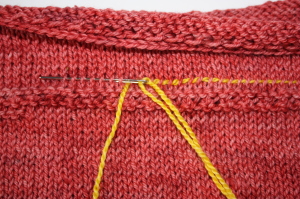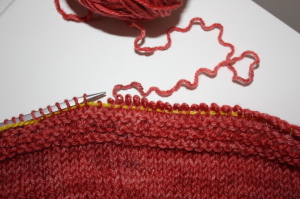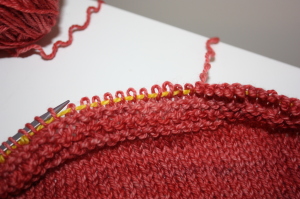 Using a lifeline in knitting or life, will save you. We don’t mean to make mistakes, but they happen and it is always nice to know you can fix them. It is easy to fix mistakes in knitting. It just takes time and patience, but in the end, nothing is ruined — your yarn might look a little kinky, but it will bounce back and your mistake will never be seen.
Using a lifeline in knitting or life, will save you. We don’t mean to make mistakes, but they happen and it is always nice to know you can fix them. It is easy to fix mistakes in knitting. It just takes time and patience, but in the end, nothing is ruined — your yarn might look a little kinky, but it will bounce back and your mistake will never be seen.
I recently used a lifeline when I was knitting a shawl. It was one of those projects where you just dive in and start knitting. I did not plan my project (silly me) I had made this once before — same wool, same pattern — I should be fine. So, off I went! Then it happened, I knew I would not have enough yarn to finish the final section of the pattern, but I knitted faster, as if I could out-run the truth. Denying that I had a problem. Admission did not set in until it actually happened — I ran out of wool. There was just nothing left to knit. So, I put down my project and walked away from it. Nothing like denial and a little silence to heal my frustration.
A few weeks later, I decided to communicate with my project. I knew it would take time, but I had to fix my mistake. No more nights of it sitting on my night table, unfinished — no conversation. We had to talk, this project and I — it had to be fixed. We needed a knitting lifeline.
The first step was to decide how far back to rip. I picked a line in the knitting, threaded a blunt tapestry needle with waste yarn and started to sew in my lifeline. It was easy, all I had to do was pick up the first leg of each stitch in the row. It took me a few nights but, Ta Da!, suddenly there was an answer to my problem. The lifeline was in place. All I had to do was put in a little effort.
 Next came the ripping. This always takes a little bravery and faith. But, it has to be done. One little pull and those stitches just started popping out. Each tug and my tension released. Fixing my knitting was turning out to be easier than ignoring the problem. Once I ripped down to that yellow line of yarn, I saw that my stitches were happily waiting for me — ready to be fixed.
Next came the ripping. This always takes a little bravery and faith. But, it has to be done. One little pull and those stitches just started popping out. Each tug and my tension released. Fixing my knitting was turning out to be easier than ignoring the problem. Once I ripped down to that yellow line of yarn, I saw that my stitches were happily waiting for me — ready to be fixed.
 I just put the knitting needle right under each stitch and suddenly, I was back in action. Once I had all of the stitches picked up. I pulled out the waste yarn, knitted the rows and finished the project. Easy as that! The finished shawl is now washed and drying. All finished and ready to be gifted.
I just put the knitting needle right under each stitch and suddenly, I was back in action. Once I had all of the stitches picked up. I pulled out the waste yarn, knitted the rows and finished the project. Easy as that! The finished shawl is now washed and drying. All finished and ready to be gifted.
Knitting is just like life — you have to recognize the mistakes, admit they are there and then put in the effort to fix them — sometimes, you need a lifeline to help you out.
I will photograph the shawl when it is all dry and share it as soon as I can get my daughter to be my model!






